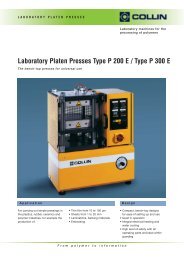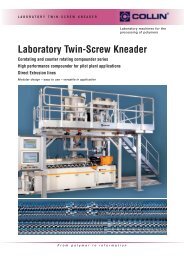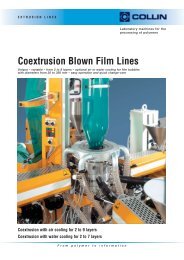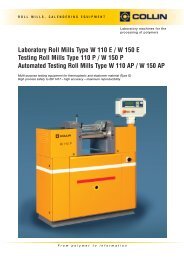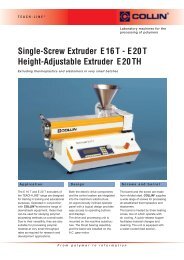Coextrusion systems for Flat Film and Sheet
Coextrusion systems for Flat Film and Sheet
Coextrusion systems for Flat Film and Sheet
Create successful ePaper yourself
Turn your PDF publications into a flip-book with our unique Google optimized e-Paper software.
EXTRUSION LINES<br />
<strong>Coextrusion</strong> <strong>systems</strong> <strong>for</strong><br />
<strong>Flat</strong> <strong>Film</strong> <strong>and</strong> <strong>Sheet</strong><br />
Innovative technologie in modular design<br />
Laboratory <strong>and</strong> pilot plants<br />
<strong>for</strong> the processing of polymers<br />
From the abstract polymer to the real properties
COEXTRUSION SYSTEMS FOR FLAT FILM AND SHEET<br />
Dies <strong>for</strong> the coextrusion of flat film<br />
Feedblock system <strong>for</strong> 2 to 9 layers<br />
The feedblock system is the most frequently<br />
used configuration <strong>for</strong> the<br />
manufacture of multi-layered films <strong>and</strong><br />
sheets.<br />
The multi-layered polymer melt is produced<br />
in the relatively narrow feedblock;<br />
this material is brought to the<br />
required final width in a conventional<br />
slot die.<br />
Special features<br />
• Adjustable slot width <strong>for</strong> each individual<br />
layer <strong>for</strong> obtaining a wide variation<br />
of different layer thickness ratios<br />
• Throttle valves <strong>for</strong> setting the flow <strong>for</strong><br />
each layer<br />
• Configurable <strong>for</strong> any combination of<br />
symmetrical or asymmetrical layers<br />
• Rotating adapter <strong>for</strong> straight or<br />
angled connection of the extruders<br />
• Production of layered materials with<br />
2 to 9 layers<br />
• Feedblock combinations with dies<br />
of 150 mm to 500 mm width<br />
Example of a five-layer feedblock<br />
with slot die of 200 mm. Using three<br />
extruders, three, four or five layers<br />
can be produced<br />
The objective is to manufacture tailormade<br />
packaging materials by combining<br />
a number of products which have<br />
complementary properties;<br />
the materials feature:<br />
• High gas <strong>and</strong> aroma barriers<br />
• Moisture block<br />
• Taste neutrality<br />
• Oil <strong>and</strong> grease resistance<br />
• Good optical <strong>and</strong> mechanical<br />
properties<br />
Slot die Adapter Feedblock<br />
• Sealability<br />
• Cost reduction by using<br />
recycled material<br />
The basic requirement <strong>for</strong> coextrusion<br />
with the feedblock system is a large<br />
common processing window with<br />
comparable viscosity of all layer materials.<br />
Section through a 5-layer feedblock <strong>for</strong> the production of symmetrical or<br />
asymmetrical layered materials.<br />
From the abstract polymer to the real properties
Multi-manifold die<br />
Manifold dies are used to generate<br />
multi-layers with materials of differing<br />
viscosity, at their processing temperature.<br />
A flow channel with a “coathanger”<br />
shape is provided <strong>for</strong> each<br />
material.<br />
The combination of feedblock with a<br />
manifold die offers the maximum flexibility.<br />
Numerous materials of similar<br />
viscosity can be covered with layers<br />
having different flow properties.<br />
Only at the end of the channel, i.e.<br />
almost at the die lips, do the various<br />
fully <strong>for</strong>med polymer films meet <strong>and</strong><br />
jointly leave the die. Manifold dies <strong>for</strong><br />
2 <strong>and</strong> 3 layers are offered.<br />
Combination of feedblock <strong>and</strong> manifold die<br />
Figure below:<br />
The illustration shows a combination<br />
of a 5-layer feedblock with a 3-layer<br />
manifold die <strong>for</strong> the production of a<br />
7-layer film or sheet.
Examples of delivered <strong>systems</strong><br />
Five-layer coextrusion system with two extruders<br />
with a calender type 136/350 <strong>and</strong> gravimetric feeding<br />
The fundamental principle <strong>for</strong> the<br />
production of individually defined layer<br />
thicknesses with multi-layered materials<br />
is the exact determination of the<br />
material throughput of each extruder.<br />
This can be effected by:<br />
• Weighing the extruder output<br />
• Gravimetric feeding (loss in weight)<br />
• Use of melt pumps between the<br />
extruder <strong>and</strong> die<br />
A system with gravimetric feeding is<br />
shown in the photograph opposite.<br />
Here the feed from the extruder to<br />
the feedblock occurs via flexible melt<br />
hoses to compensate <strong>for</strong> height <strong>and</strong><br />
axial offset.<br />
Five-layer coextrusion system<br />
with three extruders <strong>and</strong> a calender type 136/350<br />
Extruders with diameters 20, 25 <strong>and</strong><br />
30 mm, on mobile frames, can be<br />
positioned at any angle to the feed-<br />
block. The system is used <strong>for</strong><br />
producing symmetrical ‘ABCBA’ film.
COEXTRUSION SYSTEMS<br />
FOR FLAT FILM AND SHEET<br />
<strong>Coextrusion</strong> cast-film system<br />
with four extruders <strong>for</strong> five-layer cast film<br />
• Direct feed into the feedblock with<br />
short adapters <strong>and</strong> hence short dwell<br />
times<br />
• All four extruders adjustable in<br />
height <strong>and</strong> position<br />
• Die <strong>and</strong> feedblock mounted<br />
on moveable pillars<br />
• Chill-roll unit adjustable in height<br />
<strong>for</strong> fine adjustment of the distance<br />
between die <strong>and</strong> cooling roll<br />
• Additional unwinding station <strong>for</strong><br />
lamination trials<br />
The vertical arrangement of the feedblock<br />
<strong>and</strong> die enables the casting of<br />
thin films on a two-roll cast-film takeoff.<br />
Air knives or ‘electro-pinning’ enable<br />
even contact <strong>and</strong> there<strong>for</strong>e cooling as<br />
well as reducing the ‘neck-in’.<br />
• Alternatively, calendering is also<br />
possible when using a three-roll unit<br />
• With the additional installation of<br />
a rubber-covered nip roll, many<br />
techniques of film manufacture are<br />
possible, such as:<br />
• Casting • Calendering<br />
• Embossing • Backing<br />
• Laminating
COEXTRUSION SYSTEMS<br />
FOR FLAT FILM AND SHEET<br />
Technical data<br />
EXTRUDER / TYPE E 16 E 20 E 25 E 30 E 45<br />
Diameter (mm) 16 20 25 30 45<br />
Length (LD) 20 - 30 25 - 30 25 - 30 25 - 30 25 - 30<br />
Drive power (kW) 0,8 1,9 5,8 8,8 18,3/27<br />
Screw speed (Min-1) 0 - 180 0 - 180 0 - 170 0 - 160 0-140/240<br />
Throughput (kg/h) 0,1- 1,5 0,3 - 3 0,7 - 7,5 1,5 - 15 3-30/50<br />
FEEDBLOCK<br />
Width (mm) 40<br />
No. of layers 3 / 5 / 7 / 9<br />
SLOT DIES<br />
Width (mm) 150 200 250 up to 550 mm<br />
Slot width <strong>Film</strong> (mm) 0,3 - 1,5 0,3 - 1,5 0,3 - 1,5 0,3 - 1,5<br />
Slot width <strong>Sheet</strong> (mm) 0,3 - 6 (8) 1,5 - 3 1,5 - 3 1,5 - 3<br />
MANIFOLD DIE<br />
Width (mm) 250<br />
No. of layers 2 3<br />
Slot (mm) 0,2 - 2,5<br />
CALANDER / TYPE 136 / 230 136 / 350 168 / 400 168 / 600<br />
Roll diameter (mm) 72-144-72 72-144-72 3x168 (250) 3x168 (250)<br />
Roll width (mm) 230 350 400 600<br />
Drive power (kW) 0,4 0,4 3x0,5 3x0,8<br />
Take-off speed I (m/min) 0,5 - 6 0,5 - 10 0,3 - 5 0,3 - 5<br />
Take-off speed II (m/min) 3 - 30 3 - 30 1 - 20 1 - 20<br />
The technical data given provides guidelines <strong>for</strong> a basic configuration <strong>for</strong> a co-extrusion system. A detailed design<br />
can only be provided after definition of the polymers used, the layer structure <strong>and</strong> the dimension of the required finished<br />
product.<br />
Technical modifications reserved Issued 10/01<br />
Dr. Collin GmbH<br />
Sportparkstr. 2, D-85560 Ebersberg, Germany<br />
Telefon ++49 8092 / 20 96-0, Telefax ++49 8092 / 20 86 2<br />
www.drcollin.de, E-mail to: collin@drcollin.de<br />
Represented by:





